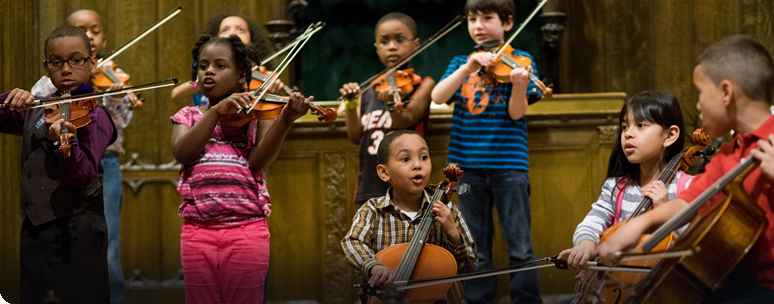El Sistema in CubaI just returned from ten days in Cuba. The official purpose of the trip, according to my general license from the U.S. Treasury Department, was to research music education for children and roles for community musicians in Cuba. It was easy to find music in Cuba. In clubs, restaurants, hotels, and on the plazas and street corners of Old Havana a visitor hears the intoxicating rhythms of Afro-Cuban jazz. Percussion—an amazing variety of drums, bells, sticks, and instruments I couldn’t name—drive the music
We visited an afterschool program for students in elementary and what the Cubans call secondary (equivalent to our junior high) schools and every boy there told us he wanted to be a musician. The older boys sang for us, what they called fusion music, which to my ear was Cuban Hip-Hop.
The Borowsky family from Baltimore, who bill themselves as The American Virtuosi, were traveling with us, carrying a cello and violin and searching out pianos and keyboards. They arranged to play Beethoven, Chopin, de Falla, and Gershwin in the Havana cathedral, at a senior citizens center, at a home for young children from troubled families, and other venues, and found enthusiastic Cuban audiences. At clubs, Emanuel Borowsky had only to take his violin out of its case and the local musicians would invite him to improvise with them. Still, I was eager to learn about music education for children and careers for community musicians, and I visited the Instituto Superior de Arte (ISA) the Cuban conservatory for advanced students in music, dance, theater, visual and media arts. Fidel Castro had such high priorities for the institution that he personally selected the campus, a luxurious former country club on the outskirts of Havana. The onetime golf course is now grassy knolls where students and visitors can relax, and famed architects were commissioned to build the facilities for each of the schools. ISA trains the dancers who go on to the famed Ballet National de Cuba, the players for the Orquesta Sinfónica Nacional de Cuba, and the actors for the Teatro National de Cuba. The schools were not in session so we did not hear a student performance, but we had an audience with the director of ISA and were able to ask questions. Venezuela is Cuba’s largest trading partner—supplying crucial oil and gas in return for doctors, literacy experts, and biotech—so after hearing an introduction to the ISA, I asked whether El Sistema, the Venezuelan program of music education, had also been imported from Venezuela. The director was familiar with El Sistema, and answered that no, Cuba did not follow the Venezuelan model, but instead had its own El Sistema. She explained that all education in Cuba is free, from elementary and secondary schools which are compulsory through high schools, universities, and graduate programs. Alongside the regular schools, Cuba also has a second parallel school system that is exclusively for the arts. These schools are available not only in Havana and the provincial cities, but in the countryside. Admission at every level is by audition, and is highly competitive. The enrollment, she explained, is a pyramid, with many students admitted at the elementary level, and fewer at each succeeding level. The system culminates with ISA, which provides conservatory-level training to the very best students in each of the arts. No other area of education or achievement, not even athletics or sciences, are recognized with special schools like the system of arts schools. The music students in these schools, and at ISA, study only classical music, though some may later end up in careers in jazz or other genres. I asked about music for students who were not at the level to attend the special schools, and she explained that the regular schools include some music at the elementary level. She did not elaborate, and I did not pursue the question. Cuba is a highly productive society with some remarkable achievements: free education and health care, the highest literacy (99.8%) in the western hemisphere, life expectancy and health statistics that dwarf those of the U.S., and remarkable achievements in biotech, agriculture, and other fields. But it remains a poor country, hampered by the long-standing American embargo and the bureaucratic restraints of a centrally planned economy, dependent on outside suppliers for essentials like fuel, and with a narrowly-based economy that is vulnerable to external events like the collapse of the Soviet Union. The limited resources of Cuba cannot afford universal education in the arts, and they have chosen to concentrate their arts education efforts on elites—dancers, actors, musicians, film-makers, and artists who will perform with the national companies and teach at the highest level. There are few young children playing Twinkle, Twinkle, Little Star on violins, but the streets and schools in Cuba are still full of music, and a lucky visitor can be treated, as my wife Heather was, to a serenade by one of the original members of the Buena Vista Social Club. -Ronald Florence, treasurer, CMW board |
